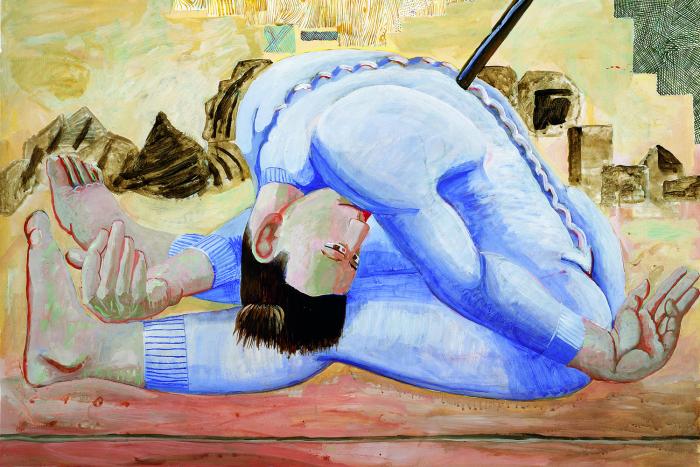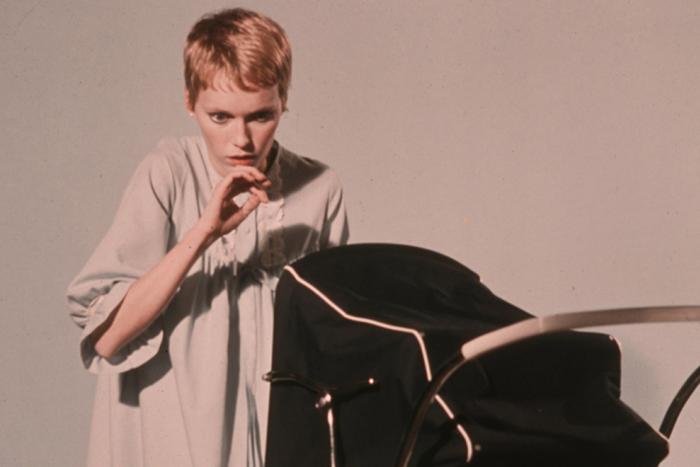Almost two years ago, the director Edgar Wright adapted Bryan Lee O’Malley’s Scott Pilgrim graphic novels—they of the titular slacker hero, the seven evil exes his dream girl obliges him to defeat, and the lightly fantastical, video-game-inflected Toronto setting—into an expensive yet heartfelt film. Then it failed to earn back the production costs. But its source material only seemed to become still more popular, books and movie alike minting new fans through countless animated GIFs and Tumblr tributes.
Though O’Malley has a new book on the way, 2013’s self-contained Seconds, he’s also decided to revisit the series that marked his emergence as a cartoonist. Starting in August, Oni Press will be publishing colourized, oversized hardcover editions of all six books, with sketches, archival documents and entirely new sequences. After hanging out and watching a massive line of fans file through at the Toronto Comic Arts Festival last May—and meeting his sister Stacey, who has a fictionalized supporting role in Scott Pilgrim—I emailed back and forth with O’Malley about Internet culture, critically revisiting his own work and the ingredients of Seconds.
How do you feel about the reception for Edgar Wright’s Scott Pilgrim adaptation now, with a couple years’ hindsight? The crude box office numbers must have been disappointing, but it seems like the movie gained a second life through countless Tumblr GIFs and cosplay outfits. Do you find that a lot of readers discovered your work that way?
There’s been a few movies this year that bombed in a much more spectacular way than ours, so I feel like the stench is kinda dissipating. I fully stand by the movie and I could literally sit here all day tracking the title on Tumblr or Twitter and see hundreds of people newly discover it in real time.
I’ve noticed the audience getting gradually younger, I think because the movie just widened the scope of awareness. It’s making me realize that people in the world in general and my audience in specific will keep getting younger every year; that the children are our future, so to speak. At this year’s Toronto Comic Arts Festival my audience was definitely as young as it’s ever been. I don’t have demographic data or anything, but mostly teens, as opposed to a signing in say 2008 when I would have put the average age around 22, 24.
Tumblr culture and the whole reappropriation-without-context thing are a double-edged sword in that they both raise awareness of my work and also kind of devalue it at the same time. But I don’t know. I guess I don’t mind. Culture is evolving and I’m along for the ride.
You’ve been on Twitter for a while, and your, uh, style on there is pretty strongly defined now: self-referential jokes (bread makes you fat???), random unfiltered thoughts, hilarious superfan trolling. But you joined Tumblr only recently, and you’re using it in myriad ways: fielding questions, sharing developmental material, reblogging fan art, posting sexy pin-ups. Why did you decide to take that plunge into the world’s worst search engine?
Because that’s where the kids are. I quietly spent time on Tumblr over the last two years and watched it kind of grow into itself, and just this year I started playing with it. I like to have a dialogue with the kids, even if the dialogue consists of someone asking a question and then me answering it very honestly and from the heart, and then the next day someone asking the exact same question because they didn’t bother to read the previous answer and really they just want the buzz of “a famous guy talked to me!”
It’s a bit frustrating when my new material gets X number of likes & reblogs, while some kid’s drawing of Sherlock in a Scott Pilgrim homage mode gets X times ten. But you start to see what makes the Tumblr kids tick, and that is its own reward.
As for Twitter, that’s still something I’m actively dealing with every day, like a therapeutic process. My latest method is for the first half of the day I stay off Twitter and leave my phone in another room. That’s the only way I get any work done. It’s not just that I waste time refreshing the window or whatever, it’s that I can read something mindbogglingly dumb and it can make me start to question everything. It makes me very existential. When I get like that, even if it’s first thing in the morning, I’m basically not going to do any work that day. So I avoid that. The rest of the time, Twitter is all fun and games. I enjoy it a lot and I’ve made a lot of weird and interesting friends on there.
Why did you decide to colour and otherwise revise the Scott Pilgrim books? From what I remember of our last interview, you’ve been thinking about doing something like that for a while...
I don’t recall there being a specific reason. During the process of the books I would have scoffed at the idea of colourization—I believe in black and white comics as their own distinct art form. But I realize I am a minority in that belief. One day last year the publisher asked if we should start thinking about reprints and we quickly decided on full-colour hardcovers.
Anyway, since the announcement I’ve had exactly zero complaints about colourization. It’s been 99 percent joyful squealing and 1 percent half-hearted grumbling about how they’ll have to buy the books again. Most people don’t consider black and white comics a finished product, I guess?
I think we’re doing them right, and I’m personally putting way too much work into them. I don’t like “cashing in,” so I’m trying to avoid that. I’m trying to always make something nice that people will like.
Was it ever agonizing, revisiting (and occasionally altering) these old pages in such minute detail? Do you consider any version of the series to be the “canonical” one?
It’s actually been an overall positive experience. Like, I get to actually fix mistakes that were made so many years ago, or I get to spend more time on something that I always regretted rushing through. On the first book I made a lot of tiny changes that people won’t notice, just “correcting” faces and hair shapes and things. On the second book I started going to town a bit and really cleaned up and redrew some stuff. To some degree I might look at that when it comes out and wonder why I changed certain things at all, but it just felt kinda cathartic. These books were produced on a pretty tight schedule and I was always rushing, so in some sense I shipped incomplete products, especially the first three books. It’s nice to be able to address that and I doubt it’ll cause, like, a full-scale revolt.
How did you and Oni Press select a colourist? Did you have a certain palette or aesthetic in mind beforehand? I know that a few people had already tried making unofficial colorations of the books.
We tried out a whole bunch of people. This process took the better part of a year. It got to where I wasn’t sure we were even going to find someone. The initial round of tests were before the movie and the second round were like a year later, when stuff quieted down again. The submissions were all over the place, all different approaches. None of them were particularly bad, they just didn’t feel right to me. Then this guy Nathan Fairbairn [4] shows up with samples that look exactly right and he’s apologizing because he had to do them all in an afternoon. Like, sorry for being so fast and great—of course he’s Canadian.
I realized it made sense to hew pretty closely to the colour palette of the movie, simply because it existed. It had already solidified this universe in people’s minds. So the first book pretty much matches the movie, with a few adjustments for where the movie didn’t quite dovetail with my imagination. Nathan has watched the first 20 minutes of the movie so many times at this point that he probably has it completely memorized.
What can you tell me about Seconds, if anything?
I came up with the general idea for Seconds right after completing the first volume of Scott Pilgrim. I worked in a restaurant in Toronto for a little while to pay the bills while writing the second volume and planning the rest of the series, and I had a few ideas for this other story, a story about a restaurant. So, Seconds is about a restaurant, and the restaurant is called Seconds, and 90 percent of the story takes place within it. Beyond that it’s really hard for me to explain and I’m going to have to work on that so I can talk about it properly when it comes out. But it’s funny and weird and kind of big and crazy despite the mundane setting.
So is Seconds a return to the more “realistic” style of Lost at Sea [O’Malley’s first, pre-Scott-Pilgrim book], or will there still be otherworldy elements like SP? Did you do any research on the restaurant industry beyond your own experiences? What’s the protagonist like?
People always ask whether the new book will be more like Lost at Sea or Pilgrim. Is this what they mean? Seconds is grounded in the reality of this restaurant environment, and I did do plenty of research, so there’s that. It takes place in a town that is like a kinder, gentler fairy tale version of reality. Then it takes off into a story that is very strange, very mental. So it’s a little of both, I guess.
The protagonist, Katie, is a loveable spaz, and she’s in practically every panel; her personality drives the story in a way that’s basically identical to my other work. They’re all very subjective worlds. But this is a new subject, so it’s got its own feeling.
Researching restaurants is probably tastier than, say, American labour history. Have you found your style changing again in drawing it?
Well, on a new book, in a new world, it’s a clean break and I felt like I could push my art into new places. I can toss out intrinsic things about the Scott Pilgrim look that always bugged me over the years, and I can bring different influences to bear. I think the new book looks pretty different, but it’ll still be instantly recognizable as me. The layouts are very different. The characters are not a huge stretch from Scott Pilgrim, but then, they’re new characters.
Which influences do you mean, in this case? And how did the preliminary process differ? Seconds is a self-contained book, for one thing—did you write a more detailed script beforehand because of that?
Well, now I can aim more overtly for like a ‘70s/’80s manga style, like Rumiko Takahashi or Izumi Matsumoto, which mostly means bigger hair and “cuter” figures. But since I’m starting from scratch I can also play with European influences and stuff – I’ve had a crush on Christophe Blain’s work forever, and I’m obsessed with Kerascoet & Hubert’s Beauté, which I read in French last year.
As a set of ideas, Seconds had years to coalesce, but turning an idea into an actual functioning story engine is another thing entirely. I ended up writing it into a really detailed outline and composing comic pages directly from that outline. This is supposed to keep things fresher, but I won’t really know if it’s working until I’m all done.
What kind of extras do you have planned for the new editions? I remember you’ve mused about one day doing a “new saga” set in the Scott Pilgrim universe. Has going through this process quashed or fed that notion?
Comics take forever, even the remastering process is taking forever, and that’s always been my main impediment as far as doing “more” Scott Pilgrim. I have vague ideas for more stories, but I’d like to keep them vague for a few years and squelch those urges and try to get something new to take off in the same way with readers.
For extras, I’m just basically going back through all my old sketchbooks and scanning anything remotely interesting. The process stuff has to be interesting to someone. The first colour book actually includes the original pitch document for the series, which is mortifying, but whatever, it’s for posterity. Later books in the series will collect various short comics from over the years, and I’m hoping to do some “new” content in the second half of the series—basically starting when I finish Seconds. Most of the new content will be in the form of backstory or plot-hole-filling. I think that stuff will be a lot of fun, or anyway I hope to have a lot of fun with it.
In retrospect Scott Pilgrim vs. the World, the movie, seems like both the mainstream zenith and final waxing of a certain phase of Torontopia—seeing and hearing all these vivid, fantastical things in a mundane, semi-shitty city founded on WASP Methodism. Before Rob Ford got elected. You haven’t lived here for some years now, obviously, but what was your sense of that from afar?
I guess I accidentally became like this ambassador from Toronto to the world. It wasn’t my intention. I just wanted to document whatever was going on in my immediate surroundings. I just liked walking around the Annex and Davenport and going to shows at Lee’s Palace and complaining about the food at Sneaky Dee’s. I wasn’t aware of the time or the place or the zeitgeist which I may have been a part of. Toronto was a mystery to me then, so I populated it with magic and secrets and weirdness. It’s still a mystery to me now.





